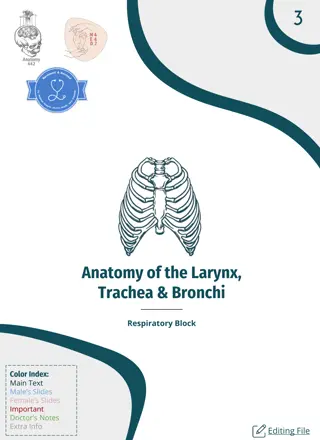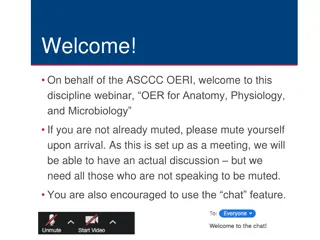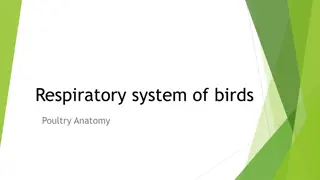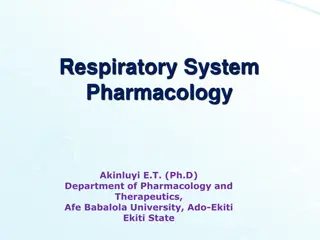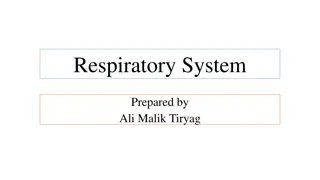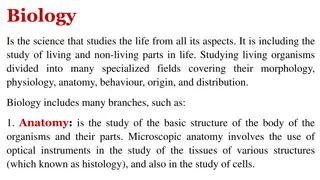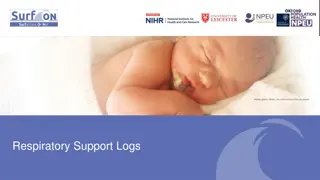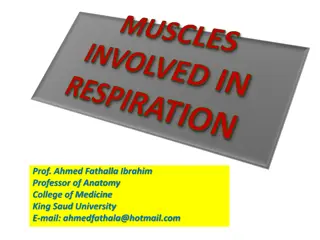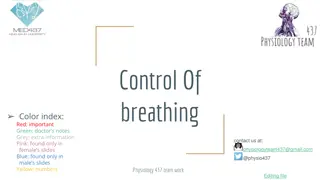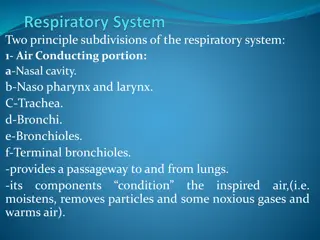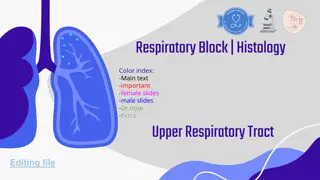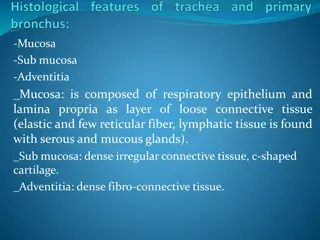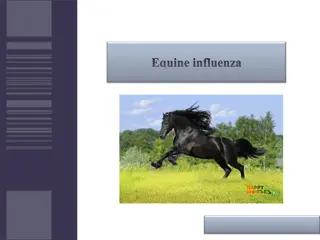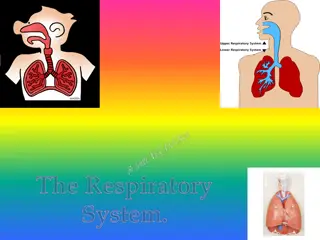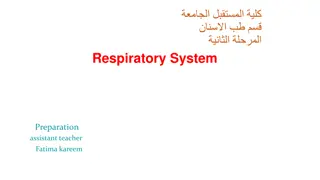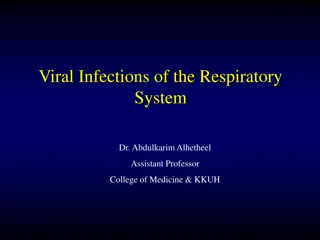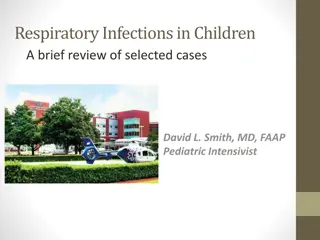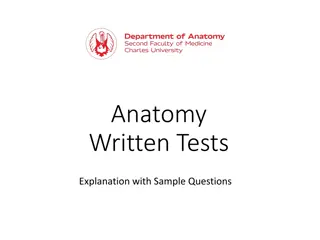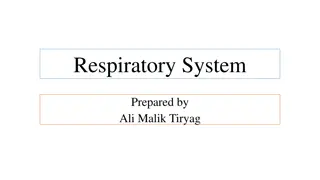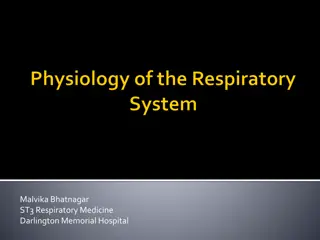Anatomy & Physiology of the Respiratory System
The respiratory system consists of the upper respiratory tract (nose, pharynx, larynx) and lower respiratory tract. Understanding its structure and function is essential in the study of respiratory diseases like pneumonia and bronchitis. Prevention, risk factors, symptoms, and treatment options are crucial aspects covered in this informative content prepared by a group supervised by Dr. Fatma Said. Explore the detailed outlines and learn about the role of nursing in preventing respiratory illnesses.
Download Presentation

Please find below an Image/Link to download the presentation.
The content on the website is provided AS IS for your information and personal use only. It may not be sold, licensed, or shared on other websites without obtaining consent from the author.If you encounter any issues during the download, it is possible that the publisher has removed the file from their server.
You are allowed to download the files provided on this website for personal or commercial use, subject to the condition that they are used lawfully. All files are the property of their respective owners.
The content on the website is provided AS IS for your information and personal use only. It may not be sold, licensed, or shared on other websites without obtaining consent from the author.
E N D
Presentation Transcript
Respiratory diseases Supervised by:- Dr./ Fatma Said
prepared by:- 1-Maisara Mohammad Ahmad. 2-Manar El-Sayed Mohammad 3-Manar Khalid Mohammad. 4-Manar Saber Abdel-mabood 5-Sameh Adeeb Zakher. 6-Amr Ahmad Ali. 7-Hoda Mahmoud Mohammad. 8-Gameel Nazmy Lahzy. 9-Hanaa Farghal Mahmoud. 10-Abdel-Azeez Mohammad Husain. 11-Mahmoud Khairy Thabet. 12-Kerolous Atef Nazmy. 13-Mahmoud Abdel-Nasser Mohammad. 14-Mohammad El-Sayed Omran. 15-Mohammad Tawfik Mohammad. 16-Mohammad Ibrahim Abdel-Halim. 17-Gondi Zakka Gondi.
Outlines:- 1-Anatomy & physiology of respiratory system. 2-Definition of respiratory diseases. 3-Types of respiratory diseases. 4-Risk factors of respiratory diseases. 5-Prevention of respiratory diseases. 6-Pneumonia : a-Definition b-Mechanism c-Types d-Causes e-Stages f-Symptoms g- Risk factors h-Diagnosis i-Complication j-Treatment k-prevention 7-Bronchitis: a-Definition b-Types c-Causes d-Transmission e-Risk factors f-Diagnosis g-Treatment h-Complications 8-Nursing role to patients with respiratory diseases for prevention.
Anatomy &Physiology of respiratory system -The respiratory system is divided into two main components:- a)Upper respiratory tract b)Lower respiratory tract
a)Upper respiratory tract: The structure of the upper respiratory tract are located outside the chest cavity. Composed of the nose, the pharynx, and the larynx.
1-Nasal cavity: Inside the nose, the sticky mucous membrane lining the nasal cavity traps dust particles, and tiny hairs called cilia help move them to the nose to be sneezed or blown out.
2-Sinuses: These air-filled spaces along side the nose help make the skull lighter
Paranasal Sinuses The total function of the paranasal sinuses is unclear. The cavities allow for the increase in the bony structure without adding significant mass. Respiratory mucosa lines the paranasal sinuses. This respiratory mucosa is ciliated and secretes mucus.
1-The ethmoid sinuses Are found between the orbits. These ethmoidal air cells are divided regionally into anterior, middle and posterior, based on the location of their apertures. The anterior ethmoidal sinus opens into the frontonasal duct. The middle group opens into the ethmoidal bulla or just superior to it. The posterior group opens onto the lateral wall of the superior nasal meatus.
2-The largest of the paranasal sinuses is (The maxillary sinus). There are 2 pyramidal- shaped maxillary sinuses located bilaterally in the maxilla of the face. It fills the bone in its entirety to reduce the mass of the maxilla. The maxillary sinus opens into the center of the semilunar hiatus found in the lateral wall of the middle nasal meatus.
3-The triangular-shaped( frontal sinuses )are found in the frontal bone superior to the orbits. These sinuses vary in size. They open at the lateral wall of the middle meatus which then continues as the semilunar hiatus, which drains the maxillary sinus.
4-Finally, the (sphenoidal sinuses) Are found in the body of the sphenoid. They open into the posterior wall of the sphenoid-ethmoidal recess.
2-Pharynx: Both food and air pass through the pharynx before reaching their appropriate destinations. The pharynx also plays a role in speech. 3-Larynx: The larynx is essential to human speech
b-Lower respiratory tract: The structures of the lower respiratory tract are located inside the chest cavity. Composed of the trachea, the lungs, and all segments of the bronchial tree (including the alveoli).
1-Trachea: Located just below the larynx, the trachea is the main airway to the lungs. 2-Bronchi: The bronchi branch from the trachea into each lung and create the network of intricate passages that supply the lungs with air.
3-Lungs: They are form the body s largest organs. They re responsible for providing oxygen to capillaries and exhaling carbon dioxide. 4-Diaphragm: The diaphragm is the main respiratory muscle that contracts and relaxes to allow air into the lungs
Definition of respiratory diseases: Are pathological conditions that affect the respiratory organs which lead to difficulties in gas exchange , and they range from mild & self limiting such as the common cold ,to life threatening diseases such as bacterial pneumonia , pulmonary embolism , acute ashma and lung cancer .
Types of respiratory diseases:- A)Upper respiratory tract infection 1-the common cold 2-sinusitis 3-tonsillitis 4-otitis media 5-pharyngitis 6-laryngitis B)Lower respiratory tract infection 1-Pneumonia 2-Bronchitis 3-Bronchiolitis
Risk factors of respiratory diseases:- 1-Age 2-Gender 3-Smoking 4-Allergies 5-Chest injury 6-Surgery 7-Exposure to chemicals &environmental pollution 8-Family history of infectious diseases
Prevention of respiratory diseases:- 1-Stop and avoid any smoking. 2-Wash your hands 3-Cover your mouth during coughing or sneezing 4-Clean your house 5-Wear a mask 6-Get your vaccines(influenza,pneumonia)
Definition Is an inflammatory condition of the lung affecting primarily the small air sacs known as alveoli.
Mechanism of pneumonia:- A schematic diagram of the human lungs with an empty circle on the left representing a normal alveola and one on the right showing an alveola full of fluid as in pneumonia
Pneumonia frequently starts as an upper respiratory tract infection that moves into the lower respiratory tract. It is a type of pneumonitis (lung inflammation). The normal flora of the upper airway gives protection by competing with pathogens for nutrients. In the lower airways, reflexes of the glottis, actions of complement proteins and immunoglobulins are important for protection. Microaspiration of contaminated secretions can infect the lower airways and cause pneumonia. The virulence of the organism, amount of the organisms to start an infection and body immune response against the infection all determines the progress of pneumonia.
Pneumonia fills the lung's alveoli with fluid, hindering oxygenation. The alveolus on the left is normal, whereas the one on the right is full of fluid from pneumonia.
Types of pneumonia 1-Hospital-acquired pneumonia (HAP):- Some people catch pneumonia during a hospital stay for another illness. Hospital- acquired pneumonia can be serious because the bacteria causing it may be more resistant to antibiotics and because the people who get it are already sick. People who are on breathing machines (ventilators), often used in intensive care units, are at higher risk of this type of pneumonia.
The person is more likely to get this type if: 1-He is on a breathing machine 2-He can't cough strongly enough to clear his lungs 3-He has a tracheostomy tube to help he breathing 4-His immune system is weak from a disease or treatment
2-Community-acquired pneumonia (CAP):- - It's occurs somewhere other than a hospital or long- term care facility. Community-acquired pneumonia can be caused by bacteria, viruses, and fungi.
3-Health care-acquired pneumonia -Health care-acquired pneumonia is a bacterial infection that occurs in people who live in long- term care facilities or who receive care in outpatient clinics, including kidney dialysis centers. Like hospital-acquired pneumonia, health care-acquired pneumonia can be caused by bacteria that are more resistant to antibiotics.
4-Aspiration pneumonia -Aspiration pneumonia occurs when you inhale food, drink, vomit or saliva into your lungs. Aspiration is more likely if something disturbs your normal gag reflex, such as a brain injury or swallowing problem, or excessive use of alcohol or drugs.
Causes of pneumonia There are several types of infectious agents that can cause pneumonia. A-Bacterial pneumonia The most common cause of bacterial pneumonia is Streptococcal pneumonia
B-Viral pneumonia Respiratory viruses are often the cause of pneumonia. Some examples include: 1- influenza (flu) 2-respiratory syncytial virus (RSV) 3-rhinoviruses (common cold) Viral pneumonia is usually milder and can improve in one to three weeks without treatment.
C-Fungal pneumonia Fungi from soil or bird droppings can cause pneumonia. They most often cause pneumonia in people with weakened immune systems. Examples of fungi that can cause pneumonia include: 1-Pneumocystis jirovecii. 2-Cryptococcus species 3-Histoplasmosis species
Pneumonia stages Pneumonia may be classified based off the area of the lungs it s affecting: 1-Bronchopneumonia Bronchopneumonia can affect areas throughout both of your lungs. It s often localized close to or around your bronchi. These are the tubes that lead from your windpipe to your lungs.
2-Lobar pneumonia Lobar pneumonia affects one or more lobes of your lungs. Each lung is composed of lobes, which are defined sections of the lung. Lobar pneumonia can be further divided into four stages based off how it s progressed: 1-Congestion. Lung tissue appears heavy and congested. Fluid filled with infectious organisms has accumulated in the air sacs.
2-Red hepatization. Red bloods cells and immune cells have entered into the fluid. This makes the lungs appear red and solid in appearance. 3-Gray hepatization. The red blood cells have begun to break down while immune cells remain. The breakdown of red blood cells causes a change in color, from red to gray. 4-Resolution. Immune cells have begun to clear the infection. A productive cough helps eject remaining fluid from the lungs.
Symptoms of pneumonia Pneumonia symptoms can be mild to life-threatening. They can include: 1-Coughing that may produce phlegm (mucus) 2-Fever 3-Sweating or chills 4-Shortness of breath that happens while doing normal activities or even while resting 5-Chest pain that s worse when you breathe or cough 6-Feelings of tiredness or fatigue 7-loss of appetite 8-Nausea or vomiting 9-Headaches
Pneumonia Risk factors Anyone can get pneumonia, but certain groups do have a higher risk. These groups include: 1-Infants from birth to 2 years old 2-People ages 65 years and older 3-People with weakened immune systems 4-People with certain chronic medical conditions, such as asthma, cystic fibrosis, diabetes, or heart failure
5-people who recently had a respiratory infection, such as a cold or the flu 6-Hospitalized people, particularly if they were on a ventilator 7-people who ve had a stroke, have problems swallowing, or have a condition that causes immobility 8-people who smoke, use certain types of drugs, or drink excessive amounts of alcohol 9-people who ve been exposed to lung irritants, such as pollution, fumes, and certain chemicals
Pneumonia Diagnosis A)Take medical history B)complete physical examination , your doctor may also order one or more of these tests: 1-Chest X-ray 2-Blood culture 3-Sputum culture. 4-Pulse oximetry 5-CT scan 6-Fluid sample 7-Bronchoscopy
Pneumonia complications Pneumonia may cause complications, especially in people with weakened immune systems or chronic conditions, such as diabetes. 1-Worsened chronic conditions If you have certain preexisting health conditions, pneumonia could make them worse. These conditions include congestive heart failure and emphysema. For certain people, pneumonia increases their risk for having a heart attack.
2-Bacteremia Bacteria from the pneumonia infection may spread to your bloodstream. This can lead to dangerously low blood pressure, septic shock, and in some cases, organ failure. 3-Lung abscesses These are cavities in the lungs that contain pus. Antibiotics can treat them. Sometimes they may require drainage or surgery to remove the pus.
4-Impaired breathing You may have trouble getting enough oxygen when you breathe. You may need to use a ventilator. 5-Acute respiratory distress syndrome This is a severe form of respiratory failure. It s a medical emergency.
6-Pleural effusion If your pneumonia isn t treated, you may develop fluid around your lungs in your pleura, called pleural effusion. The pleura are thin membranes that line the outside of your lungs and the inside of your rib cage. The fluid may become infected and need to be drained. 7-Death : In some cases, pneumonia can be fatal
Treatment -Treatment for pneumonia involves curing the infection and preventing complications. People who have community-acquired pneumonia usually can be treated at home with medication. Although most symptoms cure in a few days or weeks, the feeling of tiredness can persist for a month or more.
Specific treatments depend on the type and severity of your pneumonia, your age and your overall health. The options include The following
Antibiotics Oral antibiotics can treat most cases of bacterial pneumonia. Always take your entire course of antibiotics, even if you begin to feel better. Not doing so can prevent the infection from clearing, and it may be harder to treat in the future. Antibiotic medications don t work on viruses. In some cases, your doctor may prescribe an antiviral. However, many cases of viral pneumonia clear on their own with at-home care. Antifungal medications are used to fight fungal pneumonia. You may have to take this medication for several weeks to clear the infection.
Cough medicine Your doctor may also recommend cough medicine to calm your cough so you can rest. Keep in mind coughing helps remove fluid from your lungs, so you don t want to eliminate it entirely.
Fever reducers/pain relievers. You may take these as needed for fever and discomfort. These include drugs such as aspirin, ibuprofen and acetaminophen .


